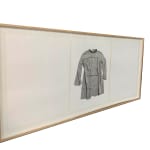


Santiago Porter
80.01 x 177.8 cm
Further images
At nine fifty-three on the morning of July 18th, 1994, a bomb exploded opposite the building of the AMIA, the Jewish Community Center, at 633 Pasteur Street in the city of Buenos Aires. The explosion Completely demolished the seven-story building and killed 85 people. The AMIA was a center for civic and social activities, exclusively, such as education, a burials department, and philanthropic activities. To date, the material and intellectual parties responsible for the massacre remain at large.
Porter put his sense of beauty at the service of the expression of pain and absence: one of many forms in which he was able to find the connection.
After the destruction and chaos wrought by the murderers, littered with dismembered bodies and charred sodden books, death…: the carefully-planned sense of beauty, light, and shadow of these photos restore the innate order of life. Not to celebrate, but rather to lend themselves to grief and the quest for justice; yet they nonetheless restore order to life. To date, the material and intellectual authors of this massacre are still free. Santiago Porter’s book recalls those murdered and their loved ones. It is also a call for justice.








